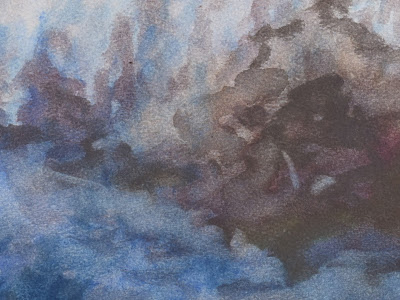― Michal Ajvaz, The Golden Age
The shoreline ingredients seem simple enough: rocks, water
and sky. The simplicity eases me away from cluttered thoughts to one version of
happiness, immersion in the natural world, a reunion with origins.
In another version of
happiness I want to reach through the photograph to make an activity of
modeling the ingredients with my hands.
Aesthetic components are well represented among the
shoreline rocks. Chaos (Χάος, undifferentiated existence)
and Cosmos (Kόσμος, the complex, orderly universe)
abound. Incalculable power lies in repose. There are reasons for it all, order
in the disarray. It is a theater of time.
A sharp and precarious
cleavage suggests the potency of change. I draw close with vigilance.
Crevices recapitulate in miniature the evolution of vast
landscapes. They undergird life's understanding of its planetary origins and
the fundamentals of its expression in art. They feature lines of teasing trails
over slopes and plateaus, possibilities and trepidations. They challenge the
random and the familiar.
I need to organize the
experience of looking at it. I put a frame around it to absorb the harmony in a
manageable scale.
The rocks exist through an endless geologic dance of form
and movement. They contain and release minerals essential to organic formulae.
They give platforms for anchorage and ambulation.
I need relief from the
dynamic geometry, the fractures and smooth-pummeled edges, the relentless grays
and browns. An incidence of life pioneers across the rocks in signature green.
At times I notice my preference for certain curves and
proportions, textures and sheens, repetitions and singularities, evidence and
mystery.
I wonder whether these
discoveries are static or eventful, reflections of compositions within my own
body and mind.
They draw me back into
the recesses of experience and forward beyond horizons.
Rocks confound the logic of degradation and beauty, of
disintegration and coherence, of irrelevance and unity, of restlessness and
harmony.
For a moment I am
hypnotized by mutual animation. Then I move on to satisfy my desires.
Rocks define the shoreline, the ceaseless inventions of the
sea.
I come and go, seeing
the rocks at different tides. Passing clouds change their appearance entirely,
as does the track of the sun. The rocks wait and I wait. Sandpipers fly in.
 |
| Sanderlings |
In the zone between
soil and sea rocks are on full display. They form panoramas that prompt visions
and vocabulary for the aesthetic world.



































